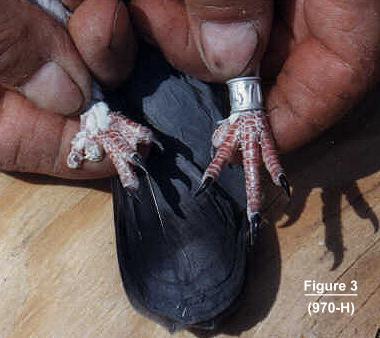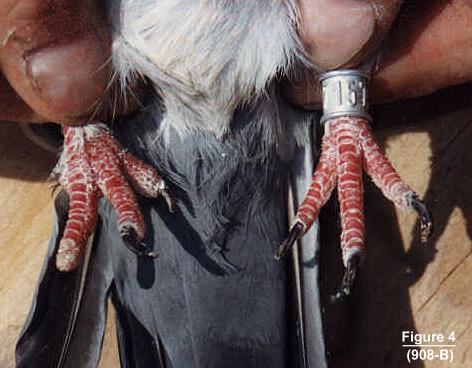Mangile's Pigeon Pages American Pigeon Journal
March 1990, pages 30 & 31."Why the "Hallux"... Like That?!
by Robert J. Mangile
During 1984-85 a gift pair (#770) of blue barred Chinese Owls produced eight (8) squabs; of which three (3) were missing toenails from both rear toes. The hen displayed the 'wobbly' trait; (see Jan. 1988, APJ p. 61); otherwise, both were normal Chinese Owls and all toes displayed toenails.
The clawless rear toed progeny seemed to suggest that this characteristic had a genetic basis and it appeared to be “recessive”. A descriptive name was needed for this condition to facilitate simple entry in my notebook. The first toe on the hind limb in all terrestrial animals is called the 'hallux', (pl. halluces). The name “clawless hallux” seemed to be appropriate. It means clawless first toe. (The counting order of avian toes are: rear = 1st, inner = 2nd, middle = 3rd and outer = 4th).
Eventually, in related stock, squabs were produced with one hallux clawless and one hallux having a claw (example, Fig. 1). Some halluces appeared clawless in new hatchlings but later developed degenerate, blunt claws. Others had thin, twisted claws that failed to culminate into a pointed tip as does a normal claw. Individual expressions were mixed; with their halluces being both clawless; one clawless and one clawed or both clawed. Specimens having both halluces clawed, occasionally had one or both claws twisted or degenerate in appearance.
Figure 1, (above left). This cock (970-B) displays clawless hallux on its left foot and a twisted claw on hallux of its right foot.
Figure 2, (above right). This hen (970-D) displays a clawless outer or 4th toe on its right foot. All other toes have claws.Early on, it seemed that the variations observed were likely a range of expressions produced by the gene(s) controlling this trait. Later, birds from this line were produced which lacked claws on the inner, middle or outer toes (example: Fig. 2 and 4). And, still others had 'extra' toe-stumps between the normal toe positions (example: Fig. 3); some with toes 'missing' to the ball of the foot (example: Fig. 4) and one specimen had a foot with all clawless stumps (not shown). These extreme examples seemed to appear after the assumed infusion of polydactyly, sideburns and porcupine.

Figure 3.
This hen (970-H) displays a normally clawed right rear toe, which is webbed to the inner or 2nd toe. The 2nd toe is fused to the middle or 3rd to over half its length. The outer or 4th toe is shortened and clawless; and, between it and the middle or 3rd toe is a clawless stump-like toe. The left foot is normally toed and clawed.

Figure 4.This hen (908-B) displays a normally clawed rear toe on its right foot. The inner or 2nd toe is normally clawed; but, the middle or 3rd toe is clawless. The outer or 4th toe is completely missing to the ball of the foot. The left foot is normally toed and clawed. Also note the outer right tail feather (R-1) grows at an angle from the other 11 rectrices. Its total width is about half that of its normal counterpart (L-1) and the webbing of the vane is about equal width on both sides of the feather shaft or rachis. The narrow, lightened, outer tail vane, present in the outer left (L-1) rectrix, is not present in this rectrix. This hen and the original Chinese Owl cock, from Pair No. 770, produced the birds in Figures 1, 2, and 3. Her genotype includes: Sb//+, py//+ and wo//+.
Last Summer (1989), the hen (908-D) in Figure 4, hatched a squab on her own in an open loft (sire unknown) that completely lacked rear toes. Not even stumps! Toes two, three and four on both feet were normal and clawed. One leg of squab had a extremely shortened tibiotarsus (the bones connecting the thigh bone to the heel; or, the 'drumstick'). The bird was fostered to another pair and was fed to weaning time; and at 39 days of age, was killed. The feet had grown in a twisted, upside-down (palms-up) position making it nearly impossible for the bird to get around. Autopsy revealed its sex to be a hen with healthy internal organs. Her legs were saved for study.
The term "clawless hallux" may seem to be inappropriate; but perhaps not!? Consider, for example: hen 908-D, (shown in Figure 4), is heterozygous for polydactyly (py// +), sideburns (Sb//+) and wobbly (wo// +). Perhaps the combination effects of sideburns or polydactyly with clawless hallux may be giving rise to the extreme cases observed. The genes controlling the excessively whorled plumage of the Chinese Owl may also be a contributing factor. It seems there is much to learn?
The blunt or twisted claws on the halluces of either one or both feet; and, the clawless halluces, might be considered as a variation in the expression of the 'clawless hallux' trait. Perhaps we can speculate that the earlier examples were produced from one mutant gene and the other extreme expressions are due to the combined affect of clawless hallux with polydactyly and/or sideburns. Agreed there seems to be confusion but we must start somewhere! The genetic symbol of “ch” for clawless hallux is presently being use in my notebook.
The two photos above were published in Issue #50, (June 1995) of "Pigeon Genetics, News, Views & Comments". The pigeon belonged to Hy Lieblich of New York; and displays what appears to be an expression of the clawless mutant. In communications with Hy Lieblich he said that this birds was a feral bluebar squeaker that visited his birds during feeding time. He described the squeaker's malformed feet as follows: "The pigeon of interest had the first and second toes present in both feet, that is, each foot had a hallux and a medial toe. And while the right foot had the third and fourth toes missing, there was a stubb for the third toe. The left foot also had no third and fourth toes, but for the first toe, or hallux, there was only a slight suggestion of a claw. The pigeon in question was rather tame, and after a few months it disappeared."
.
# # #